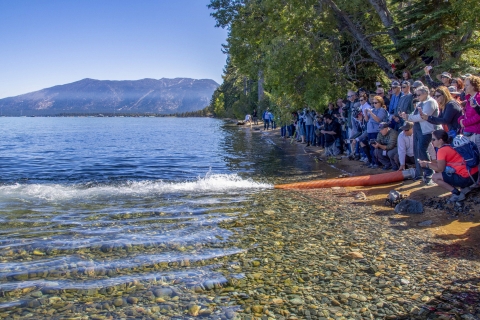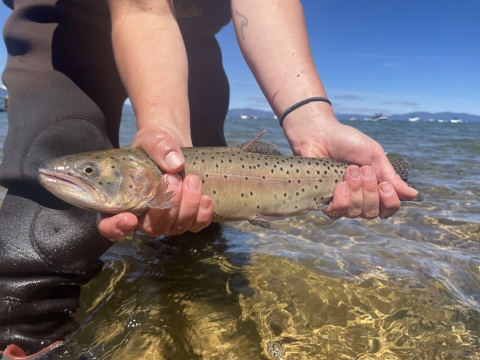Tahoe’s native fish are making a return this summer.
The Lahontan National Fish Hatchery Complex in Gardnerville, Nev., began stocking 100,000 catchable, Lahontan cutthroat trout into Lake Tahoe June 1 and will continue stocking throughout the summer as conditions allow.
The stocking is part of a multiagency and tribal cooperative effort to reintroduce the Tahoe Basin’s native trout species and expand recreational fishing opportunities to anglers. The partners involved are the U.S. Fish and Wildlife Service (USFWS), California Department of Fish and Wildlife (CDFW), Nevada Department of Wildlife (NDOW), USDA Forest Service Lake Tahoe Basin Management Unit (USDA LTBMU), Tahoe Regional Planning Agency (TRPA) and the Washoe Tribe of Nevada and California.
The reintroduction of Lahontan cutthroat trout has biological and recreational importance as well as significant cultural value to the Washoe Tribe. As the original stewards of Lahontan cutthroat trout, the Washoe Tribe has been an important stakeholder and partner since the beginning of reintroduction in the Tahoe Basin. The tribe has always been supportive of the restoration projects within Washoe ancestral lands.
The fish will be stocked at various, publicly accessible locations in both the California and Nevada portions of the lake. Approximately 20 percent of the trout will be tagged to help biologists evaluate the success of the stocking effort along with the growth, survival, and distribution of the fish.
Anglers are required to follow all fishing regulations (see Sport Fishing Regulations below) and encouraged to report any tagged fish they catch by calling the phone number on the tag (775) 861-6355. Over time, stocking will inform conservation and recreation strategies in the reintroduction of this native strain of the fish into its historic habitat.
Lahontan cutthroat trout have been stocked intermittently in Lake Tahoe since 2011, although in smaller numbers. They are the only trout native to the Tahoe Basin and the largest cutthroat trout species in the world. The fish being stocked are the Pilot Peak strain of the species, which is known for its fast growth rate and achieving exceptional size. The Pilot Peak strain is also found in Nevada’s Pyramid Lake, which attracts anglers from around the world hoping to catch one of the lake’s giant Lahontan cutthroat trout.
Lahontan cutthroat trout are listed as a threatened species under the federal Endangered Species Act. Their original listing in 1970 predates the modern act itself, which was passed in 1973. The native trout eventually disappeared from Lake Tahoe due to overfishing, damage to spawning tributaries caused by pollution, logging, water diversions, and the introduction of nonnative species. Federal and state efforts are underway throughout the fish’s native range in California and Nevada to restore the species and its habitat.
While this summer’s stocking may inform future restoration efforts, it is an initiative to expand recreational trout fishing opportunities for the public, enhance the near-shore fishery, and to foster an appreciation for this iconic native species.
Sport Fishing Regulations
Anyone 16 years or older fishing anywhere in Lake Tahoe must possess either a valid California sport fishing license or a valid Nevada fishing license. Either state’s license is valid around the entire shore of Lake Tahoe. Anglers fishing the California portion of Lake Tahoe may fish year-round and are allowed a limit of five trout per day and a 10 trout possession limit (California Freshwater Sport Fishing Regulations, section 5.85).
Anglers fishing the Nevada portion of the lake may fish year-round and are allowed a limit of five total game fish species in possession (2022 Nevada Fishing Regulations, page 44-45). Anglers are strongly advised to consult either the 2021-2022 California Freshwater Sport Fishing Regulations or the 2022 Nevada Fishing Regulations for specific regulations for the Lake Tahoe portions of each state.
Media Contacts:
Melissa Conte, U.S. Fish and Wildlife Service, (775) 861-6368
Peter Tira, California Department of Fish and Wildlife, (916) 215-3858
Ashley Sanchez, Nevada Department of Wildlife, (775) 688-1558
Lisa Herron, USDA Forest Service Lake Tahoe Basin Management Unit (530) 721-3898
Jeff Cowen, Tahoe Regional Planning Agency (775) 589-5278
Darrel Cruz, Washoe Tribe of Nevada, and California, (750) 265-8600
###
About the U.S. Fish and Wildlife Service
The U.S. Fish and Wildlife Service works with others to conserve, protect, and enhance fish, wildlife, plants, and their habitats for the continuing benefit of the American people. For more information about our work and the people who make it happen, visit https://www.fws.gov/cno/or connect with us via Facebook, Twitter, YouTube, and Flickr.
About the California Department of Fish and Wildlife
The mission of the California Department of Fish and Wildlife is to manage California’s diverse fish, wildlife, and plant resources, and the habitats upon which they depend, for their ecological values and for their use and enjoyment by the public. To learn more, visit www.wildlife.ca.gov. Connect with us at Facebook, Twitter, Instagram, and YouTube.
About the Nevada Department of Wildlife
The Nevada Department of Wildlife (NDOW) protects, restores, and manages Nevada fish and wildlife, and promotes fishing, hunting, and boating safety. NDOW’s wildlife and habitat conservation efforts are primarily funded by sportsmen’s license and conservation fees and a federal surcharge on hunting and fishing gear. Support wildlife and habitat conservation in Nevada by purchasing a hunting, fishing, or combination license. Find us on Facebook, Twitter, Instagram or visit us at ndow.org.
About the USDA Forest Service
The mission of the U.S. Forest Service is to sustain the health, diversity, and productivity of the nation’s forests and grasslands to meet the needs of present and future generations.
About the Tahoe Regional Planning Agency
Established in 1969, the Tahoe Regional Planning Agency was the nation’s first bi-state regional environmental planning agency. Our mission is to lead the cooperative effort to preserve, restore, and enhance the unique natural and human environment of the Lake Tahoe Region, while improving local communities, and people’s interactions with our irreplaceable environment. Find us on Facebook, Twitter, Instagram, or visit us at trpa.gov.
About the Washoe Tribe
Preserving, reviving and living the Washoe culture and traditions. Where: Respect for one another and tribal values promote our spiritual, physical and environmental wellness. Educational opportunities are available for all tribal members and descendants. A solid economic foundation ensures self-sufficiency for tribal success. Responsive government promotes teamwork, professionalism and accountability. On safe and secure tribal lands.





